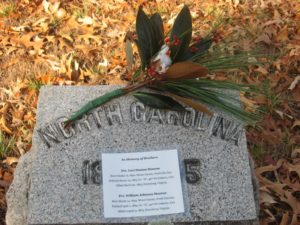SUBMITTED BY: Rick Monroe (edited and vetted by Cheri Todd Molter)
I’ve known for quite a while that my great-great-uncles, William Johnson Monroe and Levi Deaton Monroe, were both killed during the battles for Petersburg, Virginia, in 1864 and 1865. A number of times, while driving through Richmond, I’ve wanted to stop, trace their footsteps, and possibly find their resting places. I finally had that opportunity when returning from Cousin Chris Williams’ Eagle Scout award presentation in Maryland. Uncle Joe Morris and I stopped at the Petersburg National Battlefield and Blandford Church cemetery. Levi and William, older brothers of my great-grandfather, John C. Monroe, served in Company D of the 49th Infantry (North Carolina), which participated in two important stages of the Battle of Petersburg.
In June 1864, the men of the 48th Pennsylvania, a Union regiment made up of miners from Schuylkill County and commanded by Lieut. Col. Henry Pleasants—a practical mining engineer—discussed the feasibility of running a mine under the Confederate’s works (The Union Army, vol. 6). The plan was proposed by Pleasants to Burnside, who gave the project his approval. They began working on creating a 522-foot tunnel under the siege lines that ended under the Confederate defenses. They packed the tunnel with eight tons of black powder, and on the morning of July 30, 1864, they lit the fuse. The ensuing explosion made a ragged crater that was 170 feet long, 60 feet wide, and 30 feet deep in the Confederate lines (The Union Army, vol. 6). Dirt, timbers, cannon, and bodies were said to have fallen from the sky for 10 minutes after the explosion. But the Union troops were ill prepared to take advantage of the opening: Many rushed into the crater instead of around it and were trapped within the steep walls of the crater. They were easy targets for the remaining Confederates.
According to information provided at the Petersburg National Battlefield, the nearest surviving unit on the left flank of the crater was the 49th Infantry (North Carolina). Some of those men would have filled the breach and fought to stop the Union troops. It gave me chills knowing I was standing on the spot where William and Levi (or at least their fellow Tarheel Boys) had stood and fought over 150 years ago. William died four days later, on August 4, 1864. He may have died of wounds received during the fight for the crater or was killed by Federal sharpshooters afterward.
For the next nine months, Grant poured troops and supplies into the ever-growing siege lines around Petersburg. Lee, with no hope of new men or materials, stretched his lines to match the Union expansion. In late March 1865, with options dwindling, Lee held conference with Confederate President Jefferson Davis, at which it was decided to abandon the Richmond and Petersburg lines (The Union Army, vol. 6). In order cover the withdrawal of his troops from Petersburg, Lee ordered one last attack on Union lines at Fort Stedman, a small earthen encampment along the long battle line in the direction of City Point. Fort Stedman is less than a mile northeast of the crater.
At that time, Lee’s army was in desperate straits for food. The capture of Fort Fisher in January had closed the port of Wilmington to the Confederacy, thus making it impossible to obtain supplies from abroad. It had become a common occurrence for squads of Confederate soldiers, impelled by the hope of securing better rations, to desert with their arms in their hands and come over to the Union lines. About 4 a.m. on March 25, several such squads, claiming to be deserters, left the Confederate works, and when near enough, made a dash and overpowered the Federal pickets at Fort Stedman (The Union Army, vol. 6). The N.C. 49th took part in the assault, which succeeded in capturing the fort for a short time. However, the fort was recaptured by Union troops a few hours later.
Levi died the following day, March 26, 1865, possibly from wounds received in the battle for Ft. Stedman. With the Confederacy crumbling, no mention of his death is recorded in his official military records. However, at home in Moore County, an entry was made in the Monroe Family Bible: “Levi Deaton Munroe was killed at Petersburg Va. March 26th 1865.”
In 1866, the Ladies Memorial Association (LMA) of Petersburg began moving the bodies of the Confederate dead from their battlefield graves to a section of Blandford Cemetery, located about a mile from the crater. The LMA estimated the project would take a year and include about 2,500 graves. Fifteen years later, about 30,000 Confederate soldiers were buried there. Few graves were individually marked: Most are buried in mass graves identified only by their home state. Joe and I placed a small bouquet of pine, magnolia, cotton, and bittersweet on the North Carolina marker, possibly the final resting place for William and Levi Monroe. (Photo is of the marker for the mass grave of North Carolina Troops.)

